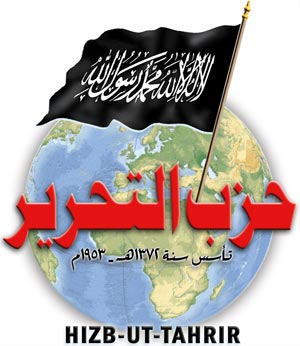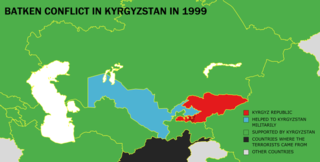Related Research Articles

The Islamic Movement of Uzbekistan was a militant Islamist group formed in 1998 by Islamic ideologue Tahir Yuldashev and former Soviet paratrooper Juma Namangani; both ethnic Uzbeks from the Fergana Valley. Its original objective was to overthrow President Islam Karimov of Uzbekistan and create an Islamic state under Sharia; however, in subsequent years, it reinvented itself as an ally of Al-Qaeda. The group also maintained relations with Afghan Taliban in 1990s. However, later on, relations between the Afghan Taliban and the IMU started declining.

Hizb ut-Tahrir is an international pan-Islamist and Islamic fundamentalist political organization whose stated aim is the re-establishment of the Islamic caliphate to unite the Muslim community and implement sharia globally.
Akromiya is an Islamist organization founded by Akrom Yo‘ldoshev.
Sayid Abdulloh Nuri, also transliterated as Abdullah Nuri, led the Islamic Renaissance Party of Tajikistan from 1993 until he died of cancer in late 2006. During the Tajik Civil War of 1992 to 1997 he led the United Tajik Opposition. Nuri and President of Tajikistan Emomali Rakhmonov ended the civil war by signing the Tajik National Peace Accord in 1997.
The Islamic Movement of Tajikistan is the branch of the Islamic Movement of Central Asia, a militant Islamist organization, that operates in Tajikistan. The IMCA, and by extension the IMT, is affiliated with Al Qaeda.

A. Elizabeth Jones is an American diplomat and government official who served as the United States Ambassador to Kazakhstan from 1995 to 1998 and Assistant Secretary of State for European and Eurasian Affairs from 2001 to 2005. She was promoted to the rank of Career Ambassador in 2004. Jones served as Chargé d'Affaires to India from 2022 to 2023. She had served Chargé d'Affaires to Egypt from October 9, 2023 to November 15, 2023.
Terrorism in Central Asia is largely a cross-border phenomenon. The source of most terrorists and terrorist organizations that operate in Central Asia is Afghanistan due to the presence of the Taliban, and more formerly, Al Qaeda militants, as well as the Ferghana Valley due to the Tajik Civil War.
Prior to the 2001 invasion of Afghanistan, the Islamic Movement of Uzbekistan (IMU) posed the greatest threat to the Karimov administration. In 2002 the IMU was reclassified as terrorist by the United States. Since the invasion, the IMU has been greatly weakened due to US military actions which cut off its supply of resources and killed its leader, Juma Namangani.
Terrorism in Kyrgyzstan has increased since the U.S. military invaded Afghanistan and overthrew the Taliban in 2001. The governments of Kyrgyzstan and Uzbekistan provided airbases for counter-terrorism operations. Southern Kyrgyzstan is increasingly sympathetic to terrorism and Islamic extremism.
Igor Rotar is a Russian journalist. From 2003 to early 2007 he was the Central Asian news correspondent for Forum 18, a human rights organization based in Norway that promotes religious freedom. He is a Russian citizen.
The threat of terrorism in Kazakhstan plays an increasingly important role in relations with the United States which in 2006 were at an all-time high. Kazakhstan has taken Uzbekistan's place as the favored partner in Central Asia for both Russia and the United States. Kazakhstan's counter-terrorism efforts resulted in the country's 94th ranking among 130 countries in the 2016 Global Terrorism Index published by the Institute of Economics and Peace. The higher the position on the ranking is, the bigger the impact of terrorism in the country. Kazakhstan's 94th place puts it in a group of countries with the lowest impact of terrorism.
The 1999 Tashkent bombings occurred on 16 February when six car bombs exploded in Tashkent, the capital of Uzbekistan. The bombs exploded over the course of an hour and a half, and targeted multiple government buildings. It is possible that five of the explosions were a distraction from the sixth, which appeared to be an attempt to assassinate President Islam Karimov. 16 were killed, and over 120 injured.
Jumaboi Ahmadjonovich Khodjiyev, better known by the nom de guerreJuma Namangani, was an Uzbek Islamist militant with a substantial following who co-founded and led the Islamic Movement of Uzbekistan (IMU) with Tohir Yo'ldosh. The IMU received substantial Taliban patronage, and was allowed to operate freely in northern Afghanistan.
The 2010 South Kyrgyzstan ethnic clashes were clashes between ethnic Kyrgyz and Uzbeks in southern Kyrgyzstan, primarily in the cities of Osh and Jalal-Abad, in the aftermath of the ouster of former President Kurmanbek Bakiyev on 7 April. It is part of the larger Kyrgyz Revolution of 2010. Violence that started between Kyrgyz and Uzbeks on 19 May in Jalal-Abad escalated on 10 June in Osh.
On 13 May 2005, protests erupted in Andijan, Uzbekistan. At one point, troops from the Uzbek National Security Service (SNB) fired into a crowd of protesters. Estimates of those killed on 13 May range from 187, the official count of the government, to several hundred. A defector from the SNB alleged that 1,500 were killed. The bodies of many of those who died were allegedly hidden in mass graves following the massacre.
The fight against terrorisminAzerbaijan is one of Azerbaijan's declared priorities. International organizations banned as terrorist include Al Qaeda, Al-Nusra Front, Azerbaijani Jamaat, Hizb ut-Tahrir, Islamic International Brigade, ISIS, Jeyshullah, and PKK. According to the Global Terrorism Database, seven people have been killed and over 20 injured in terrorist attacks from 2000 to 2015.

Hizb ut-Tahrir is a pan-Islamist and fundamentalist group seeking to re-establish "the Islamic Khilafah (Caliphate)" as an Islamic "superstate" where Muslim-majority countries are unified and ruled under Islamic Shariah law, and which eventually expands globally to include non-Muslim states. In Central Asia, the party has expanded since the breakup of the Soviet Union in the early 1990s from a small group to "one of the most powerful organizations" operating in Central Asia. The region itself has been called "the primary battleground" for the party. Uzbekistan is "the hub" of Hizb ut-Tahrir's activities in Central Asia, while its "headquarters" is now reportedly in Kyrgyzstan.
Gulmurod Salimovich Khalimov (1975–2017) was a Tajik and Islamist military commander. He was a lieutenant-colonel and commander of the police special forces of the Interior Ministry of Tajikistan until 2015, when he defected to the Islamic State. In September 2016, he was reported to have been appointed as the minister of war of IS in place of Abu Omar al-Shishani; his appointment had not been announced by IS for fears that he might be targeted in airstrikes by the anti-IS coalition. On 8 September 2017, Khalimov was allegedly killed during a Russian airstrike near Deir ez-Zor, Syria. However, the Tajik government, United Nations, and the United States believed that he was still alive by 2019, though his exact fate remained disputed. By 2020, Islamist militants claimed he had died at some point; this source was considered unreliable by the Tajik government. Regardless, the United States had removed Khalimov from their Rewards for Justice Program by 2021.

The Batken conflict was a period of armed clashes between militants of the Islamic Movement of Uzbekistan (IMU) and the Armed Forces of Kyrgyzstan, with support to the latter being provided by the Uzbek Ground Forces. It was caused by incursions of IMU militants into Uzbek and Kyrgyz territory from Tajikistan and was in part, centered on the unilateral demarcation of the Kyrgyzstan–Uzbekistan border by Uzbekistan.

A three-day border conflict between Kyrgyzstan and Tajikistan began on 28 April 2021. The clashes stemmed from a long-running dispute over a water supply facility near the village of Kök-Tash. Tajik media raised some concern over military drills in Batken prior to the conflict.
References
- ↑ Jihad: The Rise of Militant Islam in Central Asia, page 8
- ↑ Tajikistan Civil War Global Security
- ↑ Tajik Supreme Court updates terror list RadioFreeEurope/RadioLiberty
- ↑ Alleged Islamic militants' trial adjourns in Kyrgyzstan RadioFreeEurope/RadioLiberty
- 1 2 3 Analysis: Extremist threats, and doubts, in Kyrgyzstan, Tajikistan RadioFreeEurope/RadioLiberty
- 1 2 Tajikistan identifies IMU suspects in 2005 blasts RadioFreeEurope/RadioLiberty
- 1 2 Central Asia: Fighting erupts on Tajik-Kyrgyz border RadioFreeEurope/RadioLiberty
- ↑ Tajik official says Uzbeks invented regional terror group RadioFreeEurope/RadioLiberty
- ↑ Car Bomber Kills 2 in Tajikistan The Moscow Times
- 1 2 Tajik authorities say female leader of banned Islamist group arrested RadioFreeEurope/RadioLiberty
- 1 2 3 Hizb ut-Tahrir activist convicted in Tajikistan Interfax-Religion
- ↑ Tajik court jails Hizb Ut-Tahrir members RadioFreeEurope/RadioLiberty
- ↑ Tajikistan jails two alleged Hizb ut-Tahrir members RadioFreeEurope/RadioLiberty
- 1 2 Hizb-ut-Tahrir activist convicted in Tajikistan Interfax
- ↑ Russia says expelled Uzbek member Of terrorist group RadioFreeEurope/RadioLiberty
- ↑ Tajik forces 'Find bunker likely used by militants' RadioFreeEurope/RadioLiberty
- ↑ Terrorist base found in Tajikistan ITAR-TASS
- ↑ Tajikistan to create 'tourist police' after Daesh-claimed attack kills 4
- ↑ Security, drugs exercise under way in Central Asia RadioFreeEurope/RadioLiberty
- ↑ China: Border security tightened amid 'terrorist infiltration' warning RadioFreeEurope/RadioLiberty
- ↑ Tajik president: Early to speak of victory over terrorism in Afghanistan Archived 2007-09-27 at the Wayback Machine Pravda
- ↑ Tajik, Chinese Begin Counterterrorism Drill RadioFreeEurope/RadioLiberty